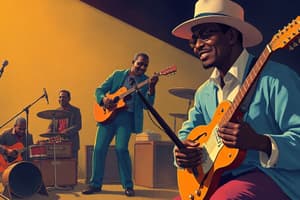Podcast
Questions and Answers
Which musician is known as the 'mother of the blues'?
Which musician is known as the 'mother of the blues'?
- Freddie Keppard
- Jelly Roll Morton
- Ma’ Rainey (correct)
- Bessie Smith
Who is recognized as the first great jazz musician?
Who is recognized as the first great jazz musician?
- Joe 'King' Oliver
- James Reese Europe
- Scott Joplin
- Buddy Bolden (correct)
Which of the following artists composed pieces in both ragtime and jazz?
Which of the following artists composed pieces in both ragtime and jazz?
- Nick LaRocca
- James P. Johnson (correct)
- Coleman Hawkins
- Bing Crosby
Which band is credited with recording the first jazz record?
Which band is credited with recording the first jazz record?
Who was known for their use of mutes and taught Louis Armstrong?
Who was known for their use of mutes and taught Louis Armstrong?
Which musician is referred to as the father of the blues?
Which musician is referred to as the father of the blues?
Who was the first full-time vocalist with a jazz orchestra?
Who was the first full-time vocalist with a jazz orchestra?
Which musician is known for being one of the first major tenor saxophone soloists in jazz?
Which musician is known for being one of the first major tenor saxophone soloists in jazz?
What is the primary characteristic of Country Blues?
What is the primary characteristic of Country Blues?
Which style of music is characterized by the use of nonsense words in improvisation?
Which style of music is characterized by the use of nonsense words in improvisation?
How did Louis Armstrong influence the evolution of jazz?
How did Louis Armstrong influence the evolution of jazz?
Which of the following is a defining feature of New Orleans Style jazz?
Which of the following is a defining feature of New Orleans Style jazz?
What is a key characteristic of swing music during the Swing Era?
What is a key characteristic of swing music during the Swing Era?
What role did the Cotton Club play in the context of jazz?
What role did the Cotton Club play in the context of jazz?
What is the main difference between Classic/Vaudeville Blues and Country Blues?
What is the main difference between Classic/Vaudeville Blues and Country Blues?
What does the term 'shuffle rhythm' refer to in jazz?
What does the term 'shuffle rhythm' refer to in jazz?
Which figure is known for leading the first integrated jazz band to tour?
Which figure is known for leading the first integrated jazz band to tour?
What is the function of a 'head arrangement' in a big band?
What is the function of a 'head arrangement' in a big band?
Which of the following styles is associated with the term 'ragged time'?
Which of the following styles is associated with the term 'ragged time'?
What does 'collective improvisation' involve in a jazz context?
What does 'collective improvisation' involve in a jazz context?
What is the significance of Congo Square in New Orleans music history?
What is the significance of Congo Square in New Orleans music history?
Which musical concept refers to the quality of sound that distinguishes different voices or instruments?
Which musical concept refers to the quality of sound that distinguishes different voices or instruments?
Flashcards are hidden until you start studying
Study Notes
Blues and Jazz Pioneers
- Bessie Smith: Renowned classic and vaudeville blues singer, influential in the development of the genre.
- Ma’ Rainey: Known as the 'Mother of the Blues,' a classic blues singer who helped shape the genre.
- Robert Johnson: Iconic country blues singer and guitarist, celebrated for his profound impact on the blues.
- Frank and Irene Castle: White couple who sanitized popular dances for white audiences, facilitating the mainstream spread of ragtime.
- James Reese Europe: Black bandleader and composer, collaborated with the Castles to popularize Black music.
- Buddy Bolden: First significant jazz musician, a cornetist without any recordings to document his contributions.
- Scott Joplin: The most famous ragtime composer, pivotal in the genre's establishment.
- Joe ‘King’ Oliver: Influential cornetist and bandleader who mentored Louis Armstrong, known for mute techniques.
- Freddie Keppard: Cornet player who refused to record first jazz music due to fears of idea theft.
- Nick LaRocca: Cornetist from the Original Dixieland Jazz Band, controversially claimed to have invented jazz.
- Jelly Roll Morton: An early ragtime and jazz pianist recognized for his role in notating arrangements in jazz.
- Paul Whiteman: Described as the 'King of Jazz,' merged jazz with symphonic forms; hired Fletcher Henderson as an arranger.
- Original Dixieland Jazz Band: First jazz band to record an album in 1917, comprised solely of white musicians.
- James P. Johnson: Recognized as the father of stride piano, known for compositions like 'Carolina Shout'.
- Sidney Bechet: A pioneering soprano saxophonist and clarinetist, key figure in New Orleans jazz.
- W.C. Handy: Often called the 'Father of the Blues,' known for 'St. Louis Blues', and was inspired by the blues heard at a railway station.
Genres and Styles
- Country Blues: Defined by a solo male performer, loose form with three-line stanzas recounting personal narratives.
- Classic/Vaudeville Blues: Female vocalists supported by small bands, followed a strict 12-bar form, featured in theaters.
- Scat Singing: Vocal technique characterized by improvisation using nonsensical syllables.
- Syncopation: Rhythmic structure that emphasizes off-beats, often creating a tension against the primary meter.
- Collective Improvisation: Multiple musicians improvising together to create a unique sound.
- New Orleans Style Jazz: Emphasized polyphony and collective improvisation, emerging in the early 1900s.
Influential Figures and Development
- Great Migration: Movement of African Americans from the South to the North, promoting jazz's popularity nationwide.
- Prohibition Era: Resulted in increased demand for live music in speakeasies, affecting jazz's evolution.
- Stride Piano: Developed from ragtime, featuring alternating bass notes and syncopated melodies.
- Tin Pan Alley: Collection of composers in NYC shaping popular music in the early 1900s.
Swing Era and Evolution
- Louis Armstrong: Multifaceted talent known for vocals and cornet; pivotal in establishing the blues as jazz's harmonic base and shifting focus to individual solos.
- Hot Five and Hot Seven: Armstrong-led ensembles that revolutionized jazz with a focus on solo performance rather than group improvisation.
- Swing (1935-1945): Dominant popular music genre characterized by big bands, high-energy rhythms, and improvisational freedom.
- Lindy Hop: Dance style created in the swing era, encouraging individual expression through improvisation.
- Chick Webb: Notable drummer and bandleader at the Savoy Ballroom, playing a crucial role in the swing era.
- Head Arrangement: Informal big band arrangements learned by ear, allowing for improvisation and audience engagement.
Key Collaborations and Contributions
- Benny Goodman: Clarinetist and swing bandleader known for leading the first integrated jazz band tours.
- Teddy Wilson: Pianist in Goodman's Trio, recognized as the first Black musician in an integrated group.
- John Hammond: Jazz patron who significantly supported various musicians and ensembles throughout the genre’s development.
- Other notable bandleaders: Count Basie, Duke Ellington, Jimmie Lunceford, and Cab Calloway, each contributing uniquely to the evolution of jazz.
Studying That Suits You
Use AI to generate personalized quizzes and flashcards to suit your learning preferences.




